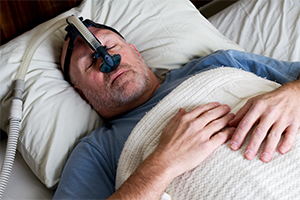What do I do about sleep apnea?

If you’re snoring at night, feeling sleepy during the day, or have other symptoms of sleep apnea, talk to your doctor and ask to be screened and tested for sleep apnea. Most sleep studies are done in a sleep center, but in some cases, you can do the test at home. A sleep study is needed to properly diagnose sleep apnea.
You can use this conversation guide to help you prepare for your visit.
In-lab overnight sleep study
This type of study requires you to stay overnight at a sleep center. It’s not like sleeping in a hospital though. The sleeping space usually looks more like a hotel room. You’ll sleep with sensors hooked up to your body that record brain waves, heartbeat, breathing, and movement.
Home sleep apnea test
Some people may be eligible for a sleep study that can be done at home. Home sleep apnea tests are less complex than in-lab tests, and you can hook up the equipment yourself. A monitor will track your sleep and other data. If the home test is inconclusive, you may have to have an in-lab test.
After either study, you’ll have a follow-up appointment to discuss the results. If you’re diagnosed with sleep apnea, the doctor will discuss treatment options.
Sleep apnea treatments
Sleep apnea treatments are very successful when followed properly. In some cases, people may find the condition goes away if they lose weight or sleep on their side. Quitting smoking and drinking alcohol can also help. Sometimes other treatments are needed.
CPAP
CPAP (continuous positive airway pressure) is the most common and recognized treatment for sleep apnea. A machine uses a steady stream of air to keep your airway open through the night.
Oral appliance therapy
Some people can use an oral appliance similar to a mouthguard to treat their sleep apnea. The device prevents the airway from collapsing by moving the jaw forward. A dentist trained in dental sleep medicine can fit you with an oral appliance.
Surgery
If lifestyle changes, CPAP, or oral appliance therapy don’t work, there are surgical options to treat sleep apnea. They include upper airway stimulation, which uses an implanted device to stimulate a nerve that controls the tongue, moving it forward while you sleep. In some cases, weight-loss surgery can help to treat sleep apnea as well.
A dedicated sleep team can help treat and manage your sleep apnea—in a way that works for you. The benefits of treating your sleep apnea are worth it.
Other options
Other changes to lifestyle or routine can help improve sleep apnea symptoms.
Weight management
In some cases, weight loss can help improve or eliminate your sleep apnea symptoms if you are overweight or obese. There is no guarantee that losing weight will eliminate your sleep apnea, though it may help.
Positional therapy
Some people have sleep apnea primarily when sleeping on their back. Their breathing returns to normal when they sleep on their side. Positional therapy may involve wearing a special device around your waist or back. It keeps you sleeping in the side position. Another option is a small device worn on the back of the neck. It gently vibrates when you start to sleep on your back. Without waking you up, the vibration alerts your body to change positions. Positional therapy can be used alone or together with another sleep apnea treatment.
Lifestyle changes
Behavioral changes such as quitting smoking or not drinking alcohol may improve sleep apnea symptoms. Alcohol relaxes your throat muscles which can cause you to snore or for your airway to collapse. If you have allergies, taking a decongestant before you go to bed may help improve airflow through your nose.
